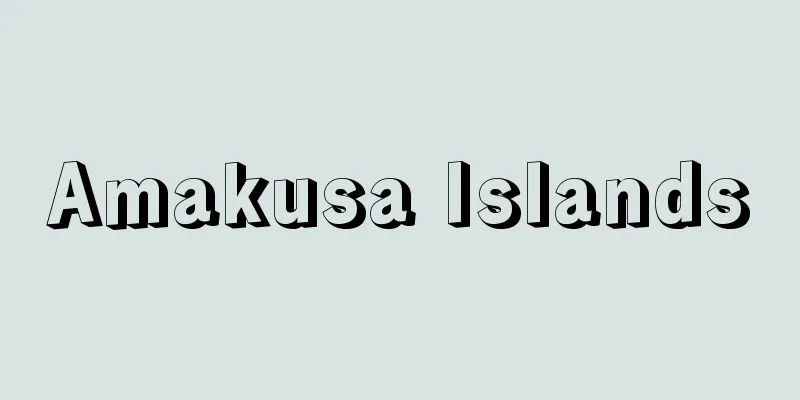Amakusa Islands

|
An archipelago located in the southwest of Kumamoto Prefecture. It consists of over 130 islands of various sizes, with the main islands being Amakusa Shimoshima (573.95 square kilometers, Kumamoto Prefecture), Amakusa Kamishima (225.23 square kilometers, Kumamoto Prefecture), Nagashima (90.57 square kilometers, Kagoshima Prefecture), and Oyanoshima (29.88 square kilometers, Kumamoto Prefecture). The entire area is a low mountainous region with an elevation of less than 700 meters, but it is divided into small mountain masses by many faults, so compared to its altitude, the mountains are deep and the landscape is mountainous, with little flat land. Geologically, most of the island is made up of Cenozoic Tertiary sedimentary rocks, but Mesozoic Cretaceous sedimentary rocks are distributed in the area extending from Tobasejima and Iwajima in the northeast, through Goshourajima to the eastern coast of Amakusa-Kamishima, Shishijima, and the southern coast of Amakusa-Shimoshima, as well as on the western coast of Amakusa-Shimoshima. In addition, Tertiary volcanic rocks of different origins are distributed on Nagashima Island. Climatically, the island is divided into two by a line that connects Hayasaki Seto, Hondo Seto, and Osaki (Minamata City). The western half of the island, which consists mainly of Amakusa Shimoshima, Shishijima, and Nagashima, has a marine climate with warm winters, heavy rainfall in summer, and a slow rise in temperature, whereas the eastern half of the island, which consists mainly of Amakusa Kamishima, Oyanojima, and Goshourajima, has slightly lower average annual temperatures and precipitation. However, in summer, it becomes quite hot due to the influence of the "Higo no Kochikaze" (a southeasterly wind that crosses the mountains). The Amakusa Islands, consisting of over 130 islands of various sizes, are located in a strategic location, bordering the Amakusa Nada, Hayasaki Strait, and Misumi Strait to the north, the Nagasaki Peninsula, Shimabara Peninsula, and Uto Peninsula, respectively, across the Amakusa Nada, Hayasaki Strait, and Misumi Strait, the Bansho-no-hana (Kagoshima Prefecture) across the Kuronose Strait to the south, the Yatsushiro Plain and the Kyushu Mountains across the Yatsushiro Sea to the east, and the Amakusa Nada, which connects to the East China Sea to the west. For this reason, in the Middle Ages, not only the powerful clans of Higo, but also those of Hizen and Satsuma, sought to possess the Amakusa Islands. For example, the powerful clan Nagashima, who was chased by the Sagara clan (Higo), sought the protection of the Shimazu clan (Satsuma), which led to the Shimazu's advance into Higo, which is a good example of this. In particular, this expansion destroyed the regional control unit that had treated the entire Amakusa Islands as one district, "Amakusa County, Higo Province," which had remained unchanged since it was established as a local administrative division under the Ritsuryo system. In other words, Nagashima, Shishijima, and other islands in Amakusa County were incorporated into Izumi County, Satsuma Province (1581), and this situation has continued to the present day. Therefore, today, when the Amakusa Islands are treated as an administrative division, Nagashima, Shishijima, and other islands are not included, but when they are treated as a geographic division, they are generally included. The Shimabara-Amakusa Rebellion was also said to have been caused by the harsh tax allocation that ignored the low productivity of the Amakusa Islands, and the Amakusa County's tax rate (initially 45,000 koku, later reduced to 21,000 koku) was far removed from reality. As described as "cultivated to the sky," the alluvial plains that spread like trees, created by short rivers, and the low mountain slopes that covered the island were used for terraced fields in various places, and sweet potatoes and wheat were cultivated as self-sufficient crops. However, the economic situation of the islanders did not improve, and they made a living by producing firewood and charcoal in the mountains and fishing in the sea, and those who could not do both jobs, regardless of gender, went out to work as servants (Karayuki-san, Nagasaki servants). Migrant workers in particular were keen to respond not only to culture but also to industries that compensated for the weakness of the economic base, and played an important role in the formation of production areas such as the introduction of bonito fishing in the late Edo period (Ushibuka and others), pit forestry (Amakusa Shimoshima, Amakusa Kamishima, Goshourajima) in the Meiji period, sardine net fishing (Ushibuka and others), sericulture (Hondo and others), prawn farming (Iwajima), dairy farming in the Taisho period (Oyanojima), open-field flower cultivation in the Showa period (Oyanojima), open-field semi-forced vegetable cultivation (Kawaura and others), and open-field controlled vegetable cultivation (Reihoku and others). After the construction of the Six Amakusa Bridges (including the Amakusa Seto Bridge), the area was closely connected to the mainland of Kumamoto via the Uto Peninsula, and labor-intensive factories such as those for textiles and electronics began to move in (Hondo, Kawaura, and other areas). Although the area had previously been designated as part of Unzen-Amakusa National Park, it had been isolated from the tourist industry due to an underdeveloped road network, but now various facilities for overnight stays (hotels, inns, etc.) have been built in this area. Even in this modern age when land transport is at its peak, sea routes between the Amakusa Islands and the surrounding areas have been secured. For example, major sea routes include Misumi (Uto Peninsula) – Matsushima (Amakusa Kamishima) – Hondo (Amakusa Shimoshima), Matsushima – Yatsushiro, Ushibuka (Amakusa Shimoshima) – Kuranomoto (Nagashima) (Kagoshima Prefecture), Nakata (Amakusa Shimoshima) – Katagawa (Shishijima) (Kagoshima Prefecture) – Moroura (Nagashima), Reihoku (Amakusa Shimoshima) – Mogi (Nagasaki City), Oniike (Amakusa Shimoshima) – Kuchinotsu (Minamishimabara City, Nagasaki Prefecture) and others, with frequent daily traffic. The complex intermarriage circle of the people of the four prefectures of Nagasaki, Saga, Kumamoto, and Kagoshima that was formed through the Amakusa Islands also speaks to the Amakusa Islands' character as a cultural melting pot. Christian cultural artifacts, which are also a tourist attraction, can be found throughout the island, where the impoverished islanders turned to Jesus for salvation and found momentary relief. This faith spread to the Amakusa Islands via Nagasaki and Shimabara, and despite repeated severe oppression, the flame of the "hidden Christians" never went out, thanks to the island nature of Amakusa and its mountainous location deep in the mountains. [Yamaguchi Morito] [Registration as a World Heritage Site] The Sakitsu village on the Amakusa Shimoshima island was registered as a World Heritage Site by UNESCO (United Nations Educational, Scientific and Cultural Organization) in 2018 (Heisei 30) as a component part of the "Hidden Christian Sites in the Nagasaki Region" (World Cultural Heritage Site). [Editorial Department, September 19, 2018] "Amakusa Local History" by Hideho Aoki (1951, Mikunisha)" ▽ "History of Amakusa" (1962), compiled and published by the Hondo City Board of Education" ▽ "Amakusa" by Osamu Yamaguchi (1963, Kinryudo)" [References] | | | | |Uto | | | | | | | | | | | | |Unzen-Amakusa National Park. Nationally designated scenic spot, nationally designated natural monument, Amakusa City, Kumamoto Prefecture ©Kumamoto Prefecture "> Myokenura Source: Shogakukan Encyclopedia Nipponica About Encyclopedia Nipponica Information | Legend |
|
熊本県南西部に位置する島嶼(とうしょ)。天草下島(しもしま)(573.95平方キロメートル、熊本県)、天草上島(かみしま)(225.23平方キロメートル、熊本県)、長島(90.57平方キロメートル、鹿児島県)、大矢野島(おおやのしま)(29.88平方キロメートル、熊本県)などを主島とし大小130余の島々からなる。全域、標高700メートル以下の低山地であるが、多くの断層によって小山塊に分けられているので、標高に比べて、山懐(やまふところ)が深くかつ多くの山地景観を呈し、平坦(へいたん)地も乏しい。地質的には、大部分が新生代第三紀の堆積(たいせき)岩からなるが、北東部の戸馳島(とばせじま)、維和島(いわじま)から、天草上島の東海岸部、御所浦島(ごしょうらじま)を経て、獅子島(ししじま)、天草下島の南海岸部に達する地域と、天草下島の西海岸部には、中生代白亜紀の堆積岩が分布している。また、長島には天草上島などとは起源の異なる第三紀の火山岩が分布している。気候的には、早崎瀬戸―本渡(ほんど)瀬戸―大崎(水俣(みなまた)市)を連ねた線で二分される。西半の天草下島、獅子島、長島を主島とする地域は、冬暖かく、夏に雨が多く、しかも気温上昇の鈍い海洋性の気候を呈するのに対し、東半の天草上島、大矢野島、御所浦島を主島とする地域は、年平均気温、年降水量ともやや低少である。しかし、夏には「肥後のこち風」(山越えの南東風)の影響を受け、かなり高温になる。 大小130余の島々からなる天草諸島は、北に天草灘(なだ)、早崎瀬戸、三角ノ瀬戸(みすみのせと)を挟んで、それぞれ長崎半島、島原半島、宇土(うと)半島、南に黒之瀬戸を挟んで番所ノ鼻(鹿児島県)、東に八代海(やつしろかい)を挟んで八代平野、九州山地とそれぞれ相対し、さらに西で東シナ海に連なる天草灘に臨む要地に位置する。このため、中世には肥後の豪族だけでなく、肥前、薩摩(さつま)の豪族も天草諸島の領有をもくろんでいた。たとえば、相良(さがら)氏(肥後)に追われた豪族長島氏が島津氏(薩摩)の保護を求め、島津の肥後進出の契機をなしたのは、その好例といえる。とくに、この進出は、律令(りつりょう)制の地方行政区画として定められて以降、変わることなく持続されてきた天草諸島の全域を「肥後国天草郡」一郡とする地域掌握単位を崩した。すなわち、天草郡下の長島、獅子島などが薩摩国出水(いずみ)郡下に編入(1581)され、この状態はこれ以降、現在に至るまで続いている。したがって今日、天草諸島を行政区画単位として扱う場合には長島、獅子島などを含めないが、地理区画単位の場合には含めるのが一般的である。 島原・天草一揆(いっき)の背景には、天草諸島の低生産性を無視した過酷な年貢割付(ねんぐわっぷ)もあるといわれるほど、天草郡の郡高(初め4万5000石、のちに2万1000石に減)は実情とかけ離れたものであった。「耕して、天に至る」とまで形容されたように、短い小河川がつくりあげた樹枝状に延びた沖積地はもとより、島を覆う低山地斜面は、各所で段々畑に利用され、自給作物であるサツマイモ、麦の栽培が行われた。それでも島の人々の経済状態は好転せず、山方にあっては薪炭製造、海方では漁労と生業を兼ね、兼業のできないものは男女を問わず出稼ぎ奉公(長崎奉公、からゆきさん)に出た。とくに出稼ぎ者は、文化だけでなく、経済基盤の脆弱(ぜいじゃく)性を補う産業に対しても鋭敏に反応し、江戸後期のカツオ釣り漁の導入(牛深(うしぶか)ほか)、明治時代の坑木林業(天草下島、天草上島、御所浦島)、イワシ網漁(牛深ほか)、養蚕業(本渡ほか)、クルマエビ養殖(維和島)、大正時代の酪農業(大矢野島)、昭和期の花卉(かき)露地栽培(大矢野島)、野菜露地半促成栽培(河浦(かわうら)ほか)、野菜露地抑制栽培(苓北(れいほく)ほか)などの産地形成化に重要な役割を演じた。天草六橋(天草瀬戸大橋をも含む)架設後は、宇土半島を陸橋として、熊本本土とのつながりが密接化し、繊維、電子関係など労働集約型工場の進出(本渡、河浦ほか)がみられるほか、それまで、雲仙天草国立公園(うんぜんあまくさこくりつこうえん)に指定されていながらも、道路網の未整備から観光産業と無縁であったこの地に、滞在(宿泊)型観光に対応する諸施設(ホテル、旅館など)がつくられてきた。 陸上交通全盛の現代においても、天草諸島と相対する周縁地域との海上交通路は確保されている。たとえば、三角(宇土半島)―松島(天草上島)―本渡(天草下島)、松島―八代、牛深(天草下島)―蔵之元(長島)(鹿児島県)、中田(天草下島)―片側(獅子島)(鹿児島県)―諸浦(しょうら)(長島)、苓北(天草下島)―茂木(もぎ)(長崎市)、鬼池(おにいけ)(天草下島)―口之津(くちのつ)(長崎県南島原市)などは主要海路で、日常の往来も頻繁である。天草諸島を仲介にして形成された長崎、佐賀、熊本、鹿児島4県民の錯綜(さくそう)した通婚圏は、文化的な坩堝(るつぼ)としての天草諸島の性格を物語ってもいる。 観光資源でもあるキリシタンにまつわる文物は、貧困にあえぐ島の人々がその救いをイエスに求め、つかのまの安らぎを得たもので、全域でみいだされる。長崎、島原を介し、天草諸島に伝播(でんぱ)したこの信仰は、厳しい弾圧の繰り返しにもかかわらず、「隠れキリシタン」としてその灯をたやすことのなかったのは、天草の島嶼性と、山懐の深い山地性に依存している。 [山口守人] 〔世界遺産の登録〕天草下島の崎津(さきつ)集落は、2018年(平成30)、ユネスコ(国連教育科学文化機関)により「長崎と天草地方の潜伏キリシタン関連遺産」の構成資産として、世界遺産の文化遺産に登録された(世界文化遺産)。 [編集部 2018年9月19日] 『青木秀穂著『天草郷土史譚』(1951・みくに社)』▽『本渡市教育委員会編・刊『天草の歴史』(1962)』▽『山口修著『天草』(1963・金龍堂)』 [参照項目] | | | | | | | | | | | | | | | | | |雲仙天草国立公園域。国指定名勝 国指定天然記念物 熊本県天草市©熊本県"> 妙見浦 出典 小学館 日本大百科全書(ニッポニカ)日本大百科全書(ニッポニカ)について 情報 | 凡例 |
Recommend
Aksel Sandemose
1899‐1965 Norwegian novelist. Born in Denmark, he ...
Metaphysical Poetry
In a broad sense, it can refer to poetry of philos...
pañca-skandha (English spelling) pancaskandha
…A classification method of existence that has be...
Kosovo [Province] (English spelling)
An autonomous province of the Republic of Serbia i...
Persimmon cake - Kakizuki
...Historical texts from the Muromachi period inc...
Italian Credit Bank - Italian Credit Bank
…Official name: Italian RepublicRepubblica Italia...
Bhakra Dam
A multipurpose dam built by damming the Sutlej Riv...
talc
Mg 6 [Si 8 O 20 ](OH) 4 . Also called talc. A phy...
Local fix - Local fix
During the Edo period, this referred to the Shogun...
Suzuki Umeshiro
1862-1940 A businessman and politician from the M...
Hansen, Lars Peter
Born: October 26, 1952. Champaign, Illinois. Ameri...
Random error
Random errors without bias. Source: Asakura Publis...
Accusation - Accusation
A complaint is a declaration of intent made by a ...
Golden Bat
…At that time, a kamishibai storyteller who was d...
Giffen goods - Giffen goods
…There are exceptional cases where the law of dem...









